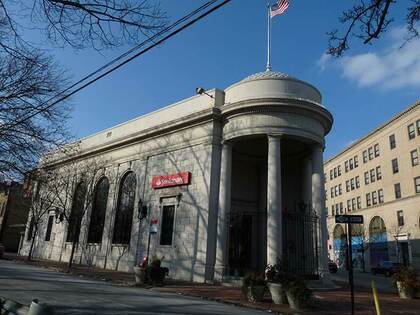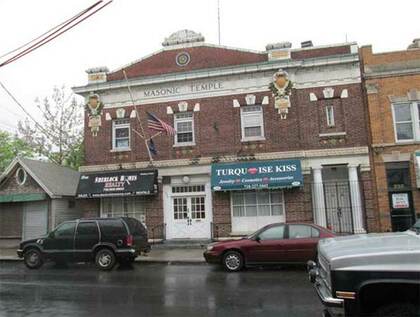Today, I thought I would feature a trio of Staten Island post offices that are architecturally interesting. Many New Yorkers have never set foot on the island, despite the free ferry fare from Battery Park, and even many tourists (I ride the ferry often and English is only occasionally heard) simply get the next boat back once reaching the island. Many New Yorkers believe that Staten Island is insular and has a “nothing to see here” vibe, despite its large amounts of parkland and wilderness areas, but that only goes so far with urbanists. As far as entertainment goes, the St. George Theater, magnificently refurbished and revived a couple of decades ago, attracts top-name acts (albeit veteran ones) with Chicago, Foreigner, Diana Ross and George Thorogood scheduled to play in late summer and fall. Some also cite its overall politics, more conservative than the rest of the city. Even the most famed native at present, former Saturday Night Live comic Pete Davidson, hasn’t had kind words.
Yet, a look at several neighborhoods in the borough reveal beautiful buildings by top-name architects. Above is the monumental St. George Post Office on Bay Street, a short walk from the ferry. While the nearby Staten Island Borough Hall was designed by Carrere and Hastings (their most notable Manhattan building was the New York Public Library on 5th Ave.) Completed in 1931, the post office is the work of Charles Follen McKim, William Rutherford Mead and Stanford White, under the direction of the then-Supervising Architect of the Treasury, James Knox Taylor. All three of the firm’s founders had died by 1919, but the firm carried on until the 1990s including mergers and acquisitions. The firm designed some of New York City’s best-known and fondly remembered buildings, including the second Madison Square Garden, where White was shot by the jealous husband of his girlfriend, showgirl Evelyn Nesbitt; the Bowery Savings Bank, the Washington Square Arch; the Brooklyn Museum; much of Columbia University; the original Penn Station; and its still-standing partner across 8th Avenue, the James Farley Post Office, now the Senator Daniel Moynihan Train Hall.
The St. George Post Office is a duly impressive building with marble pilasters (attached columns) and Corinthian tops, with a pair of the largest decorative urns I’ve ever seen at the main entrance on Bay Street. Unfortunately I always happen by on weekends, so I was unable to check out any murals within: I’ve found that post office murals often depict their neighborhoods of long ago.

Stapleton and Clifton are two adjacent neighborhoods on Staten Island’s northeast coast along Upper New York Bay. The Vanderbilt family held much land here in the early 19th century; in 1836 Minthorne Tompkins (the son of Vice President Daniel Tompkins) and merchant William Staples established a ferry to Manhattan and founded the village at Bay and Water Streets. German immigrants built numerous breweries in the area in the 1800s including Bachmann, Bechtel, and Piels, whose brewery was in business on Staten Island until 1963.
Among the most notable and strangest aspects of Stapleton’s history was the presence of the National Football League, which fielded a team known as the Staten Island Stapletons here from 1929 through 1932. The Stapes were a semipro team founded by restaurateur Dan Blaine in 1915, who played halfback for the team until 1924. Over the following couple of seasons, the Stapes would play exhibitions against pro teams from the NFL and the 1920s version of the American Football League, and after they rolled up a 10-1-1 record in 1928, including a 3-1 record against NFL squads, the Stapes joined the NFL the next season. playing in tiny Thompson’s Stadium on Tompkins Avenue, a site now occupied by Stapleton Housing. Led by halfback Ken Strong, a New York University graduate, the Stapletons compiled a 14-22-9 record against NFL competition in four years. The Stapes played an exhibition schedule in 1933, with some games against NFL teams, before Blaine folded the team and Strong joined the New York Giants.
Recently word came that Santander Bank, the longtime tenant of the classic Staten Island Savings Bank opposite Tappen Park at Water and Beach Streets, will be vacating the building. Fortunately the building itself, 100 years old in 2025, has been landmarked and will not be torn down. Staten Island Savings Bank originated in 1864 and began operations three years later, with brewer John Bechtel among the founders. The 1925 building was designed in an Italian Renaissance style by yet another prominent firm, Delano & Aldrich, taking advantage of its triangular plot by adding a dramatic entrance of a colonnaded portico.

Tottenville is the southernmost tip of Staten Island, and within it is the southernmost point in New York State. British naval officer captain Christopher Billopp was its first European settler in 1678, and within a couple of years, had built a stone mansion at the foot of today’s Hylan Boulevard that would figure prominently in American history as the Conference House. The Billopps remained Tories, loyal to the British, throughout the Revolution and so had their lands confiscated at the end of the Revolution. The story goes that Staten Island is a part of New York State, not New Jersey, because Capt. Billopp won a bet that he could circumnavigate Staten Island in one day.
The Totten family owned a large amount of property in the area in the 18th Century, and after a series of names like Unionville, Bentley Dock, and others, the village settled on a name befitting its major property holders.
When I first visited Tottenville in the 1970s, it was rather more rural and insular than it is today, when new housing developments are springing up, almost one per year. Tottenville’s southern area remains undeveloped, with large swaths of forest and tall bluffs overlooking the junction of Raritan Bay and the Arthur Kill (the waterway’s name is derived from the Dutch Achter Kill, or “back river.”
In spite of its remoteness Tottenville has been the terminus of the South Shore line of the Staten Island Railway since the 1860s, and three of the island’s major roads, Arthur Kill Road, Amboy Road and Hylan Boulevard, also lead here. Until a few years ago, Tottenville was home to two Staten Island Railway stations, one at the line’s terminus and another called Atlantic, after the now-defunct Atlantic Terra Cotta Company, once one of Staten Island’s largest employers, creating the decorative materials used on skyscrapers and for fire-resistant cladding. Atlantic went out of business until 1935 and its smokestack stood until 1988; only the railroad station remembered it. The station before it in Richmond Valley, Nassau, was named for the Nassau Smelting and Refining Company, which was also lost to the Depression. Both stations were replaced by the new Arthur Kill station.
The cornerstone for the Masonic Temple for Huguenot Lodge #381 on Main Street south of Amboy Road was laid with great fanfare on June 12, 1909. There was a gathering of hundreds with marching bands, speechmaking and pageantry. The Huguenot Lodge was named for French Protestants forced to leave their country because of religious intolerance who settled in Staten Island’ s south shore in the 1700s.
The temple was completed in 1910 by architects Charles Thrall and Charles Schmeiser. Thrall was Superintendent and chief designer for Atlantic Terra Cotta Works elsewhere in Tottenville, and colorful terra cotta is featured all over the exterior. Such was the importance of Atlantic Terra Cotta to Tottenville’s economy that a small railroad station on what was then called Staten Island Rapid Transit was built near the plant in the 19th Century. The temple also served as Tottenville’s post office for many years.
Kevin Walsh is the webmaster of the award-winning website Forgotten NY, and the author of the books Forgotten New York (HarperCollins, 2006) and also, with the Greater Astoria Historical Society, Forgotten Queens (Arcadia, 2013)

